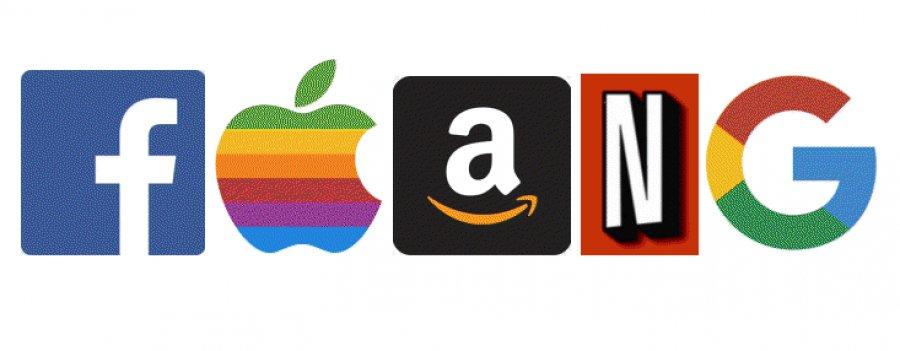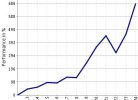Wie viele Leserinnen und Leser von grossmutters-sparstrumpf wissen, lese ich regelmäßig Mitch Zacks’s Wochenende-Kolumne (als Gratis-Newsletter). Die heutige „Warnung“ von Mitch Zacks vor den FAANG-Aktien möchte ich euch nicht vorenthalten.
Und das aus zwei Gründen.
Erstens. Habe ich vor zwei Jahren angefangen, den Begriff FANG durch FAANG zu ersetzen. Ich habe also APPLE als zweites A, zusätzlich zu AMAZON mit unter den wachstumsstarken Technologieaktien gesehen. In den letzten Tagen habe ich festgestellt, dass das die meisten Kommentatoren – zumindest die amerikanischen – mittlerweile auch so machen. Auch Mitch Zacks ist zu diesem Akronym übergegangen. Vor zwei Jahren machte das ernsthaft niemand den ich kannte. So sehr hat sich seither der Blick auf APPLE geändert.
Zweitens. Habe ich mir in der vergangenen Woche mal alle wikifolios angeschaut, die sich ähnlich gut entwickeln wie mein wiki Global Champions (über 12 Monate rund 38 Prozent im Plus) und die ähnlich groß sind (derzeit 560.000 Euro). Puhich habe gestaunt.
Fast alle diese wikis waren reine Tech-Wikis, die den Anlegern keinerlei Diversifikation bieten. Um es deutlich zu sagen: Ich kann und will diesen Trend nicht mittragen.
So sehr ich hier auf grossmutters-sparstumpf für APPLE eintrete, für FACEBOOK und für AMAZON – ich bin unter keinen Umständen bereit, die Idee eines diversifizierten Portfolios zu opfern.
Wer die letzten Entscheidungen in meinem wikifolio Global Champions mitverfolgt hat, der weiß, dass ich DISNEY aufgestockt habe, CHIPOTLE MEXICAN GRILL vom Umfang her verdreifacht habe, SHERWIN WILLIAMS gekauft und John DEERE ebenfalls wieder aufgestockt habe.
Und ich habe AMAZON schweren Herzens aber doch aus voller Überzeugung auf unter 10 Prozent zurückgestutzt. Bei aller Begeisterung für die scheinbar nicht aufzuhaltenden FAANG-Aktien – Diversifizierung hat einen Sinn. Sie soll Anleger schützen. Sie soll sie vor einer zu einseitigen Ausrichtung ihrer Depots schützen.
Wenn die Anleger beginnen, von ihr abzulassen, dann sollten wir alle sehr aufmerksam sein. Hier kommt der Beitrag von Mitch Zacks:
HOW FAANG STOCKS PUT THE DIVERSIFIED PORTFOLIO IN DANGER
Most readers know the return metrics surrounding the „FAANG“ stocks, namely that these five companies (Facebook, Apple, Amazon, Netflix, Google) have widely outperformed the S&P 500 and pretty much every other category or index during this bull market. There have been a few periods where the S&P 500 may have been negative had it not been for the FAANG stocks carrying so much weight.
For many investors, a natural response to this information is the desire to get in on the action. My guess is that investors routinely ask advisors how many shares of the FAANG stocks they own, and whether it might make sense to own more. That’s what worries me.
We see this type of behavior often when it comes to investing, but we tend to see it more around market tops or when there is an exaggerated amount of hype for a category or specific security. In the late 1990’s, just about everyone was pining for the dotcoms. Just last year, it was bitcoin driving investors mad. Neither turned out to be a sound investment, as far as we can tell.
Instead of looking for short-term gains, the key in my view is to maintain a long-term approach. I suggest avoiding the urge to get caught up in day-to-day movements or the hype surrounding a specific security, category or companies like FAANG stocks, and instead focus on economic data releases, earnings reports, and other key economic factors!
To help you do this, we are offering all readers a look into our just-released September 2018 Stock Market Outlook report.
This report will provide you with our forecasts along with additional factors to consider:
• What produces U.S. optimism in 2018?
• Forecast for the S&P
• Small-cap vs. large-cap returns
• Which sectors are hot and which are not?
• What industries within those sectors most merit your attention?
• Odds of recession
• And much more.
In this week’s column, we’re picking on the FAANGs not because we necessarily think they are in a bubble, but because these stocks seem to be having an effect on investors where the allure of high double-digit returns is outweighing the desire for long-term, risk-adjusted returns. It becomes a constant battle of, „why settle for boring, diversified portfolio returns when I can just load into these FAANG stocks instead?“
And, in my view, therein lies the danger to diversification. Whether it’s FAANG stocks, cryptocurrencies, junk bonds, gold, or whatever other ‚hot‘ security is all the hype, investors are often tempted to abandon a long-term plan in favor of the possibility of big short-term gains.
With FAANG and technology stocks being such big leaders of late in this bull market, it may feel like broad diversification is coming at a cost. It’s almost as though prudent investors are being advised to watch the party from the sidelines.
It follows that investors start to get return envy, and then they begin to analyze their portfolios for weak holdings, wondering why they’re invested in laggard stocks instead of the FAANGs. For some investors, this performance weakness becomes an issue that needs to be addressed or fixed, instead of being seen as an issue of correlation, where assets are held with the intent of being distinctive and differentiated. This element of diversification that is designed to ’smooth‘ out returns over time, instead becomes a feature that can hold back an investor back.
In my view, what happens next is the ultimate danger to diversification: rather than believing that prudent diversification is crucially important to achieving risk-adjusted returns in line with their long-term goals, they see diversification as inhibitive to their ability to keep pace with the rapid ascent of the hottest security on the market, whether it be tech stocks or FAANGs or gold or whatever else. When an investor reaches this point, the risk of making an error is about as high as it gets, in my view.
Bottom Line for Investors
The idea of diversification is to create a portfolio designed to address an investor’s long-term return needs through a range of potential outcomes. Diversification is also rooted in the historical wisdom of owning non-correlated assets so that return streams vary and are often the opposite of other assets in the portfolio. This approach has been a time-tested method for ’smoothing out‘ returns over time.
The temptation to shift a portfolio into concentrated positions (like FAANGs) is both common and difficult to resist. But, just remember that portfolio holdings moving in ‚unison‘ all of the time – even if it’s with big returns – might actually be a sign of weakness, not success.
To help you avoid this mistake, I suggest keeping an eye on economic data releases, earnings reports, and other key economic factors. Our Just-Released September 2018 Stock Market Outlook Report, will give you insight into just that!
This Special Report is packed with newly revised predictions that can help you base your next investment move on hard data. For example, you’ll discover Zacks‘ view on:
• Which sectors are hot…and which are not
• 2018 end of year forecast for the S&P 500
• Why global oil prices are rising again
• Small cap vs. large cap returns
• Our view on the odds for a recession in 2018
Mehr lesen
Den Market Outlook von ZACKS INVESTMENT für September kam heute an. Ich lese ihn regelmäßig, zusätzlich zu dem von Ken Fisher und Fisher-Grüner. Die letzten beiden unterscheiden sich kaum, Fisher-Grüner veröffentlicht mehr oder weniger eine Übersetzung der amerikanischen Fassung von Ken Fisher, hat aber doch auch immer ein paar eigene, europäische Akzente.
Der Market Outlook von ZACKS ist umsonst. Es empfiehlt sich aber, das eigene Vermögen großzügig einzuschätzen und mit etwa 500.000 Dollar anzugeben. Den Market Outlook gibt es hier.









Ich denke das die FANG- oder auch FAANG-Aktien zu sehr gehypt wurden. Wenn es negative Unternehmensnachrichten gibt, ist ein Aktienkursabsturz schnell da. Und dann wird sich so mancher Zocker eine blutige Nase holen.
Solche Abstürze sind in der Regel kurz. Auf lange Sicht sind die FAANG-Aktien ein wahrer Segen für das Depot. Man sollte sie nur nicht zu hoch gewichten.